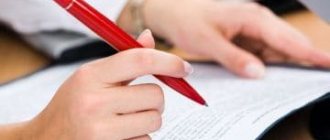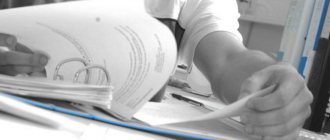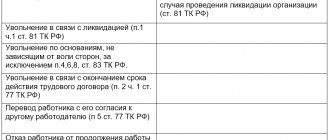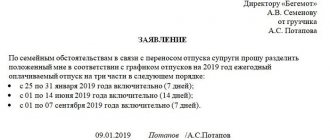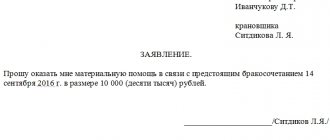When a child enters a preschool educational institution, his personal file is drawn up. If necessary, characteristics may be written down for the child. This type of document indicates all comprehensive information and is issued without fail after graduation from kindergarten.
Dear readers! Our articles talk about typical ways to resolve legal issues, but each case is unique. If you want to find out how to solve your particular problem, please use the online consultant form on the right or call. It's fast and free!
A character reference for a kindergarten student may be required from the teacher when the child enters primary school and requires compliance with certain drafting rules.
Why is a teacher’s reference for a kindergarten student necessary?
Characteristics for a kindergarten student are required in the following situations:
- upon further admission to educational institutions for the student’s personal file;
- if necessary, visit a psychiatrist;
- for guardianship authorities, if there is a need to resolve issues that affect the interests of the child;
- if the parents file a divorce process and decide through the court with whom the minor will remain;
- for transfer to another preschool institution when moving;
- if a police report is received.
Good to know! This type of document may be needed in any situation; very often the reference is necessary for disabled children who are registered for additional classes with specialists.
Who writes the characterization?
This type of document is complex, therefore the following persons are involved in the process of its preparation:
- psychologist;
- group teacher;
- speech therapist.
Note! In cases where such specialists are not available in the kindergarten, the teacher provides general information.
What data does it contain?
The document must indicate the following information:
- name of the preschool institution;
- last name, first name of the child for whom the reference is being drawn up;
- Date and place of birth;
- general information about parents and their place of work;
- information about the minor’s skills, what courses he attended and what specialists worked with him;
- development of motor skills and the presence of mental deviations from the norm;
- information about speech development, the presence of developmental anomalies;
- assessment of the development of the child’s abilities and aptitude for certain types of activities;
- activity and passivity of the pupil;
- ability to use study skills in reading and oral presentation of text;
- characteristics of the pupil’s health;
- Date of preparation;
- initials of the teacher providing such information.
Note! The characteristics must be signed by parents, who thus confirm that they have no complaints against the teacher and agree with the information provided.
If a child has any disabilities and is involved in special groups, it is necessary to provide information on the child’s condition at the time of compilation of the profile.
And also indicate comparative information about the child’s condition at the time of admission to the preschool institution and at the time of drawing up the document.
Characteristics for social protection for a preschooler
9. Alicia, in accordance with her age (4 years), has developed attention, auditory and visual memory, and imagination. Visual-figurative and elements of logical thinking are quite well developed. The child has good speech development and vocabulary. In gaming activities he is active, most often he is the initiator of games and the distribution of roles. In play, study, and work activities: diligent, collected, self-confident. He remembers songs, fairy tales and poems well. Loves listening to music, drawing, communicating with children.
We recommend reading: Can maternity capital be used if the child is under 3 years old?
5. Game activity: indifference or interest in toys, favorite games, does he understand the rules of the game, does he follow them, does he make changes to the content of the game, accessibility of an imaginary situation, role in a collective game, behavior in a conflict situation, does he reflect his experience in the game , (not) able to support the game.
Guidelines for compiling characteristics
When compiling a profile, it is necessary to provide information about the student as completely as possible. This document will be the basis for further work with the child by specialists. Incomplete information can greatly reduce positive qualities.
To compile the document, you can use the following recommendations:
- Social information about a minor. This paragraph should include all information about the child’s family. If possible, indicate family relationships. If there are diseases among relatives that may carry a genetic predisposition, this type of information is also indicated. Material assessment of the family in which the pupil lives.
- Peculiarities of pedagogical assessment of a student. This paragraph provides information on the student’s mastery of all the basics of everyday activities. The predisposition and skills of the minor in any particular direction are indicated. The degree of perception of information that the student receives during classes. Perseverance and ability to listen to the teacher.
- The play activity of the pupil also plays a role in drawing up the document, since the child, especially in the first years of life, shows most of his emotions in a playful form. At this point, you should describe how the child manifests himself in logic games. How friendly he can be in group games. The student’s desire to demonstrate leadership abilities.
Advice from experts for compiling a complete profile for a student:
- conduct observation of the pupil in his natural environment;
- conduct testing in various fields of activity, which will identify predisposition to a particular occupation;
- When drawing up a document, you should not indicate information without good reason. In this type of document, educators' assumptions cannot be used;
- through communication with the pupil’s parents and relatives, find out who is the priority for the child;
- Using psychological tests and conversations, identify the state of the atmosphere in the family circle and how it affects the student.
For each kindergarten teacher, a specific methodology is selected to study the general condition of the child.
The characteristics cannot be compiled only on simple observation; to reduce the likelihood of missing any important information, one should obtain an expert assessment from several specialists and combine it in the characteristics.
A correctly compiled description serves as a further basis for observation and work with a minor child.
Note! In many situations, general templates can be used to help educators draw up a document. However, such actions are considered erroneous and can hide the child’s individual characteristics and hinder further development in certain directions.
Didn't find the answer to your question? Find out how to solve exactly your problem - call right now: +7 (Moscow) +7 (812) 309-53-42 (St. Petersburg) It's fast and free!
Fill out form
The characteristics are filled out in a certain sequence, in accordance with the generally accepted plan. You can rely on the information given in the table:
| № | Chapter | Description |
| 1 | General information about the student | Full name. Diagnosis (if there are diseases or developmental defects). Day, month and year of birth. Start date of study and previous place of study (if available). Place of residence. If there were long periods of time when the child did not attend classes, then indicate in detail the reasons. |
| 2 | Family Description | First name, last name, patronymic (mother's and father's). Parents' place of work. Other family members. Who is more involved in raising the baby (picks him up and brings him to kindergarten)? Are there any complaints about the parents’ upbringing of the child (they don’t spend enough time, they don’t do it at all)? |
| 3 | Pupil's health | Is it often more child? Is your appetite good? Do you have problems sleeping? Describe chronic pathologies (if any). |
| 4 | Knowledge, abilities and skills developed during studies | Description of knowledge: - Knowledge of mathematics: Can distinguish the concept of “one” from “many”? Can you count in order? If yes, then indicate the interval. Are you able to match the number named by the teacher with the corresponding picture? Compares by superimposing pictures or knows the composition? Can solve examples within certain limits? Solve problems independently, based on the examples given? — Knowledge of colors: General concepts. Points to the ones you need and groups them? — Form: General concept. Does it group different species? Will he be able to correlate an object with a geometric figure at the behest of the teacher? Magnitude: General concept. Will be able to identify things by size and group them in descending (ascending) order? Does he use words in his vocabulary that characterize the concept? — Time orientation: Knows what is meant by time? Is he oriented? Can you name the days of the week in order? Defines the value of day, month, year? Orientation in space: Understands what it is and how to navigate it? Have you learned to determine the position of toys in relation to yourself? Description of speech: - Vocabulary: Is your vocabulary good? If limited, then to what extent and by what parts of speech? Are there syllabic defects when reproducing simple or multisyllabic words? — Grammatical structure: What does the child know about grammar? Will he be able to independently determine the number and gender of the words given by the teacher and find the main members of the sentence? — Pronunciation: Description of deviations when pronouncing words: — as the load increases, speech becomes blurred; - omission, displacement, replacement and distortion of sounds during conversation are observed. Does he recognize the teacher’s words well? — Speech: Is it age appropriate? What sentences does he use during a conversation (simple, complex)? Can answer questions asked? To what extent? Can you create your own sentences following the teacher’s example? — Skills that characterize the degree of literacy acquisition: Is he able to fully find parts of speech in a sentence and perform sound analysis? Will he be able to find the words that the teacher guessed from the named sounds? Can read individual syllables? |
| 5 | Features of motor skills | Describe the features of general motor skills. If there are deviations in the tempo or rhythm of movements, then indicate which ones. Characterize the pupil’s manual motor skills: - range of movements; — pace of movements; - lack of motor skills (if any); — accuracy or inaccuracy of coordination of movements. Indicate the child's dominant hand in the description. |
| 6 | Descriptions of activities | Describe self-care skills: - Can you go to the toilet independently? — How well does he maintain hygiene? —Are you able to get dressed, put on your shoes (tie your shoelaces) and comb your hair? - Will he be able to eat? — Have you been taught how to use cutlery? — Cleans up after himself (puts toys and books in their places, makes the bed)? Tell us about the gameplay: - What games do you like and how much time do you devote to them? — Do you like to play certain roles? — Does it follow through to the end? - Likes to follow rules? — How to treat your peers during the course? — Does he show imagination and ingenuity during the process? — How well does it resolve conflict situations? — Does he use his experience gained in previous games? — Can it disrupt the play of other children? Assess creativity: - Does he fold objects correctly (matryoshka, pyramid, figurines)? — Makes certain numbers or figures from matches and other materials? -Are you able to draw? Assess the complexity of the drawings. — Can he sculpt from clay, plasticine and other materials? — Can I copy an object from a sample? Tell us about your attitude towards learning: - How does he behave in class? — Does it bother your peers and the teacher? — How quickly does one become exhausted (tired)? — What is the pace of work (fast, slow, chaotic)? —Are you able to accept help from strangers? If so, which one (verbal, practical, educational)? — How well does he overcome difficulties during training? gives up what he started immediately; does not give up until the last moment; spying on what others are doing; nervous; goes to a teacher or peers for help; independently looks for a way out of the situation. |
| 7 | Personal qualities | How adequate are the reactions to the surrounding reality? Active or passive when performing certain actions? Does he show initiative (in games, in school)? How compliant, capricious, whiny, intrusive or shy is the child? Does he often show excessive irritability and aggressiveness towards teachers or peers? Is he deceiving his teachers? Is there a desire to come to the rescue, tell the truth and protect others? Does he handle criticism well? |
| 8 | Description of the nuances associated with the emotional-volitional sphere | Characterize the predominant mood of the student: - emotionally depressed; - overly aggressive; - gloomy; - closed; - embittered; - friendly; - calm; — passive; - easily excitable; - constantly afraid of failure; - shy; - passive when communicating; - uninitiative; - compliant; - whiny; - capricious; - immediately refuses offers; - prone to displaying anger; — becomes animated when performing important tasks; — shows courage, determination and perseverance during classes. - easily suggestible. |
| 9 | Dynamics of development | Based on the characteristics given, describe in detail how quickly the child develops. It is advisable to mention strong personal qualities and study skills. |
| 10 | Recommendations | Provide recommendations for correcting existing deviations. It is important to hear the opinion of the teacher, the director of the preschool educational institution and the speech pathologist. |



